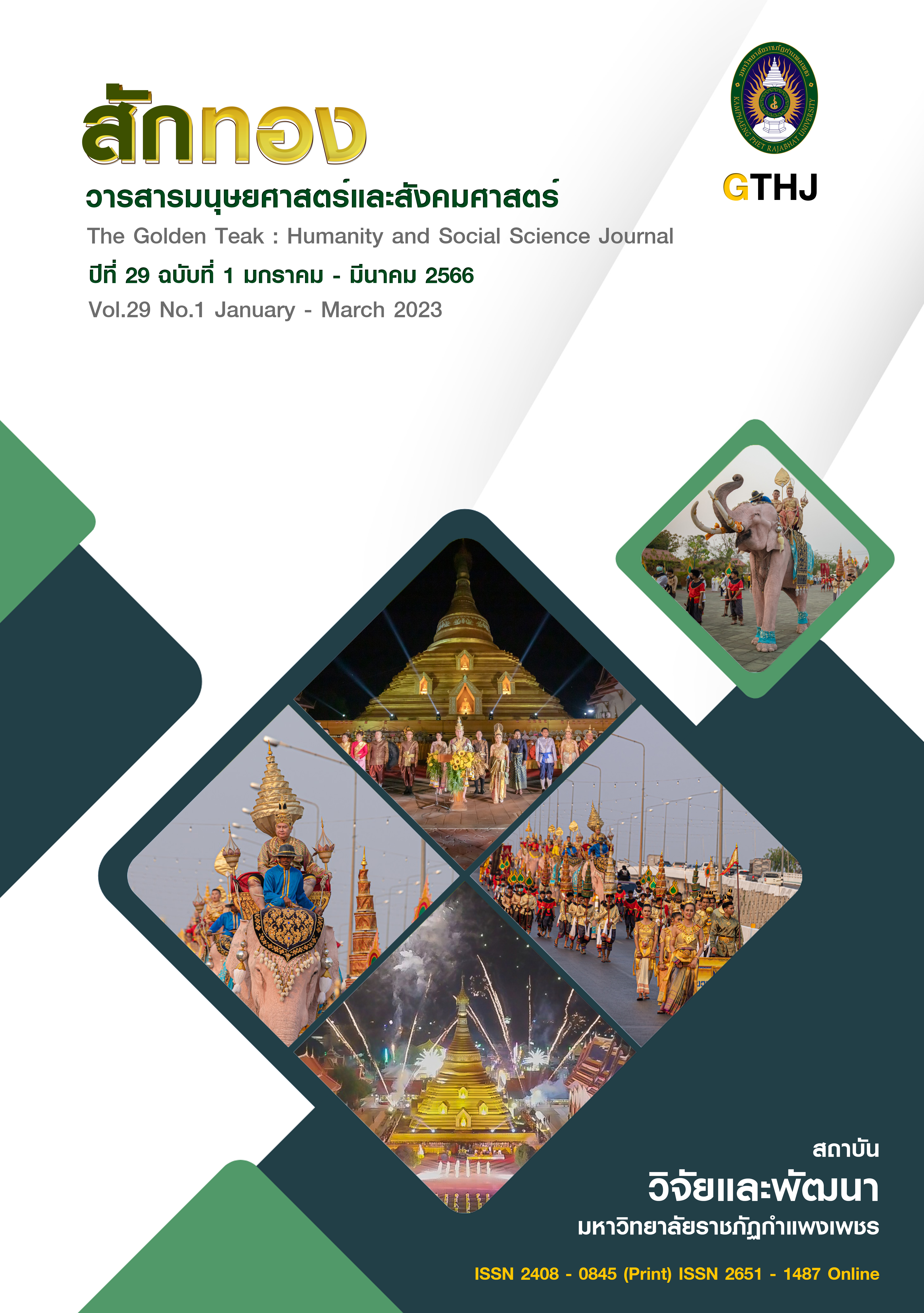The Development of Creative Thinking by Phenomenon Based Learning
Main Article Content
Abstract
The objectives of this research were 1. To study problems and needs for the development of creative thinking. 2. To develop creative thinking activities using by Phenomenon based learning. 3. To experiment with creative thinking activities using by Phenomenon based learning; and 4. To study the satisfaction with creative thinking activities using by Phenomenon based learning. The samples of this study were Children with Intellectual Disabilities with I.Q. 35-49 and had Retention problems, unable to communicate but can understand the use of language and without other disabilities conditions. All of them were in Pre-kindergarten in The Special Education Center, Pibulsongkram Rajabhat University, 2 people by purposive sampling.
The samples of this study were 45 students studying in Mathayom 1 at Wachiraprakarn Wittayakom School, Kamphaeng phet Province by purposive sampling. The instruments utilized in this study were 1) the interview form. 2 )the creative thinking activities using by Phenomenon based learning. 3) the creative thinking assessment tests, and 4) satisfaction assessment form. The data were analyzed by using percentage, mean, standard deviation and content analysis. The research found that 1) The results of the study problems and needs for The Development of creative thinking, In the present, The teaching and learning process does not focus on the development of creative thinking. There are not many teaching styles and teaching methods that develop students' creative thinking and its use is not widespread. Therefore, the teaching and learning management process should be developed to Development of Creative Thinking by Phenomenon Based Learning. 2) The results of the development of creative thinking activities by Phenomenon based learning and creative thinking assessment form be appropriate and Congruence to standards. 3) The experimental results of creative thinking activities using by Phenomenon based learning found that after teaching higher than before teaching; and 4) the results of the study of satisfaction towards creative thinking activities using by Phenomenon based learning of students found that The students' overall satisfaction was at the highest level.
Article Details

This work is licensed under a Creative Commons Attribution-NonCommercial-NoDerivatives 4.0 International License.
บทความที่ได้รับการตีพิมพ์เป็นลิขสิทธิ์ของวารสาร สักทอง : วารสารมนุษยศาสตร์และสังคมศาสตร์ สถาบันวิจัยและพัฒนา มหาวิทยาลับราชภัฏกำแพงเพชร
ข้อคิดเห็นใดๆ ที่ปรากฎในวารสารเป็นวรรณกรรมของผู้เขียนโดยเฉพาะ ซึ่งมหาวิทยาลัยราชภัฏกำแพงเพชรและบรรณาธิการไม่จำเป็นต้องเห็นด้วย
References
Buason, R. (2009). Research and Development of Educational Innovations. Bangkok : Kham Samai. [In Thai]
Butktanyu, O. (2018). Phenomenon-Based Learning for Creating a Holistic Perspective and Accessing the Real World of Students. education journal Chulalongkorn University, 46(2), 348-365. [In Thai]
Chindanurak, T. (2016). Development and assessment of creativity in educational institutions. Education Journal, 27(1), 1-12. [In Thai]
Distham, K. (2014). Development of creative-based learning management activities on the subject of Collage from natural materials For students in Grade 2. Rayong : Pluak Daeng Pittayakom School Secondary Education Service Area Office, District 18. [In Thai]
Garrison. (1954). Educational psychology. Ohio : Charles E. Morrill Publishing century-Crofts. [In Thai]
Guilford, J.P. (1971). The Nature of Human Intelligence. New York : McGraw Hill.
Mahawijit, P. (2017). Innovation of learning from Finland. NSTDA Magazine, 46(3), 40-45. [In Thai]
Hallman, Ralph J. (1971). Techniques of creation Techniques of Creative Teaching. Teaching Creation Thinking. New York : Holt , Rinehart and Winston, Inc.
Krodee., H. & Tungkasamit, A. (2017). Development of Creative Skills and Achievement. Learning with a class study process (Lesson Study) by using the Synetics teaching model for the course Sor 23102 Social Studies for Grade 3 students. Graduate Research Edition Khon Kaen University, 11(4), 243-253. [In Thai]
Lapa., K. & Jongnimitsathaporn, P. (2016). The development of creativity and achievement. Learning by using a Creative-Based Teaching Model (CBL) in conjunction with student graphics. Mathayom 1, Sor 21103, Social Studies. Nong Bua Lamphu : Kung Kaew Wittayakarn School Secondary Education Service Area Office, District 19. [In Thai]
Phruesachainimmit, A. (2018). Development of a model of visual arts teaching and learning management through a thought process creative for students in Mathayom 1. Nakhon Si Thammarat : Wat Tha Phae Municipality Secondary School. [In Thai]
Phuthong, K. (2007). The development of learning outcomes. creativity and a durable understanding of the environment Around the students in grade 2 with synetics learning management. Veridian E-Journal, Silpakorn University, 5(1), 378-393. [In Thai]
Silander, P. (2015). Phenomenon-based learning. [Online]. Available : http://www.phenomenaleducation.info/ phenomenon-based-learning.html [2021, September 29] [In Thai]
Srisaat, B. (2011). Principles of preliminary research. (9 th ed.). Bangkok : Suwiriyasan. [In Thai]
Symeonidis, V. & Schwarz, J.F. (2016). Phenomenon-based teaching and learning through the pedagogical lenses of phenomenology: The recent curriculum reform in Finland. Forum OSwiatowe, 28(2), 31-47.
Thanaphawarachot, P. & Thong-em, A. (2017). Development of a series of syntactic learning Activities to promote creativity in the visual arts of students in Grade 3. Journal of Graduate Studies, Dhurakij Pundit University, 20(2), 269-283. [In Thai]
Thongnamsub, B. (2019). Creativity Development and Learning Achievement through Learning Management creative as a base about heat energy of students in grade 1. Master of Education Thesis Science Education Maha Sarakham Rajabhat University. [In Thai]
Timsee, K. (2019). Creativity Development and Learning Achievement Using the Teaching Method Creative as a Base (CBL) of Mathayom Suksa 1 students. Kamphaeng Phet : Ruangwit Pittayakom School. [In Thai]
Torrance. Palue E. (1963). Education and The Creative Potential. Minneapolis : The Lund Press.


